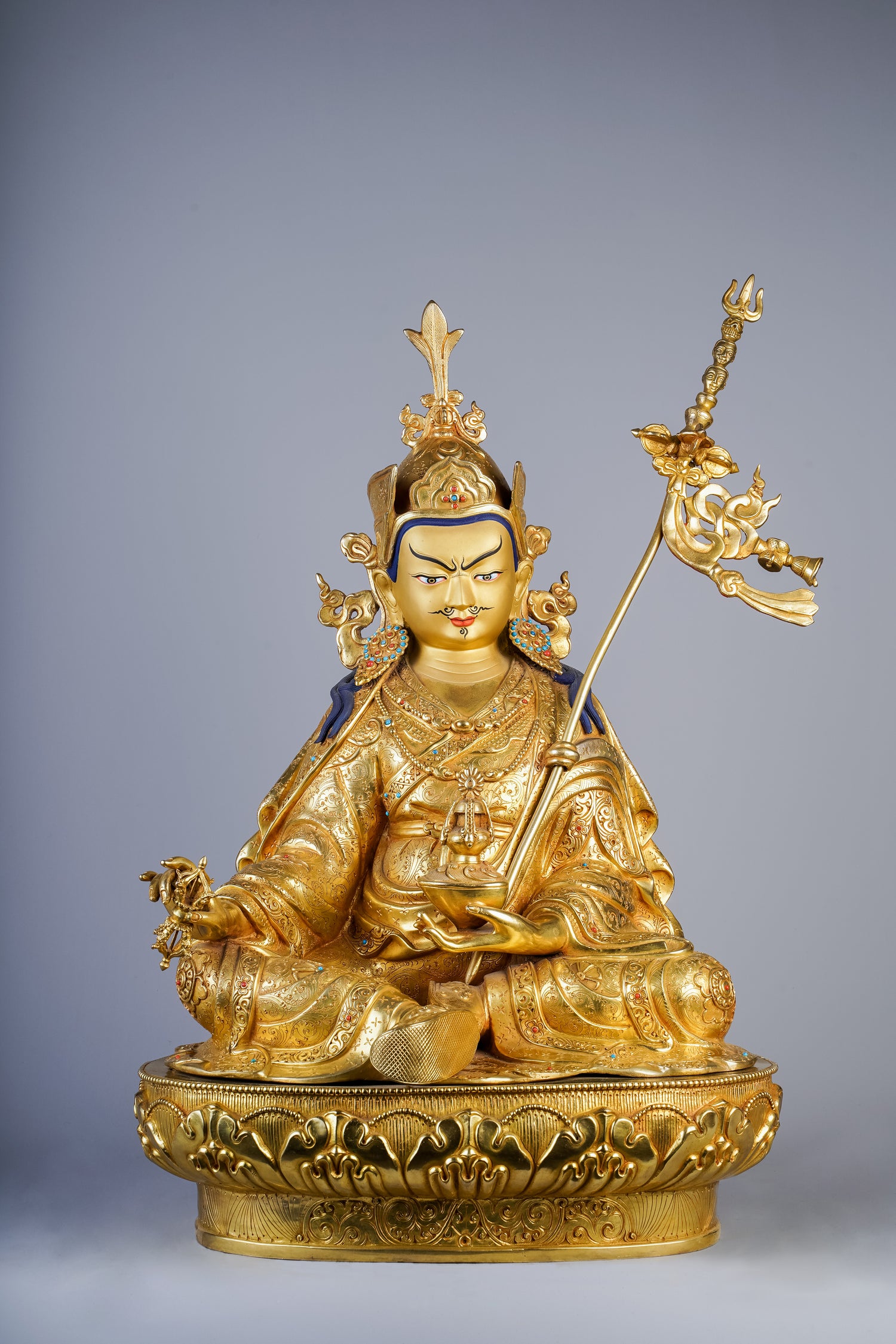
Padmasambhava: The Lotus Born Master
Guru Padmasambhava - པདྨ་འབྱུང་གནས། - 莲花生大士
Revered as the Second Buddha in Tibetan Buddhism, Padmasambhava is also considered as a manifestation of Amitābha Buddha, the Buddha of infinite Light, representing the enlightened power of speech. In the Tibetan Buddhism, enlightened beings are said to have three essential qualities – body, speech, and mind – and Padmasambhava is especially connected with the power of speech, helping to teach, guide, and awaken others through his words and blessings. Padmasambhava is said to have transform end the lives countless beings through the transmission of Vajrayāna teachings. Besides doctrinal transmission, he is also said to have subjugated local deities and spirits, transforming them into protectors of the Dharma, thus integrating indigenous beliefs within the Buddhist cosmological framework.
Padmashambhava played a central role in the construction and consecration of Samya Monastery, the first Buddhist monastery in Tibet when he was invited by King Trisong Detsen in the 8th century. Hence, he is celebrated as the one responsible for the transmission of Tantric Buddhism to Tibet and is credited with laying the foundations of Nyingma, the oldest of the four major schools of Tibetan Buddhism. According to historical and terma (treasure) accounts, he subdued malevolent spirits and local deities obstructing the establishment of the Dharma, converting them into Dharma protectors—a pivotal act that allowed Buddhism to take root in harmony with indigenous Tibetan beliefs.
Iconography of Guru Padmasambhava
-

Serene yet Wrathful Face
Padmasambhava, often depicted with a luminous complexion that appears white yet resonates with a warm, reddish glow, carries an expression that embodies both serenity and a hint of wrathfulness. His peaceful smile contrasts with the wild intensity of his gaze, which appears to penetrate the hearts of those he seeks to guide and tame.
-

The Symbolic Feathered Crown
Padmasambhava is frequently depicted wearing a lotus crown adorned with reflective mirrors, and a variety of dazzling jewels, multicolored feathers, commonly identified as peacock feathers, symbolizing transmutation of poison into wisdom. However, in certain Nyingma oral traditions, these are described as vulture feathers, emphasizing high vision and evoking the sky-like awareness of the Great Perfection
This crown, a symbol of enlightenment, is enhanced by silk streamers that cascade down, signifying the peak of all philosophical views. Below the crown, a delicate tiara of colorful ribbons gracefully trails.
-

Multi layered drapes: multiple spectrum of Buddha’s teaching
His attire consists of a beautifully tailored gown adorned with blue sequins that shimmer like starlight. Over this gown, he drapes three Dharma robes, each symbolizing the complete spectrum of the Buddha’s teachings: Śrāvakayāna, representing personal liberation through discipline; Mahāyāna, emphasizing universal compassion and the bodhisattva ideal; and Vajrayāna, embodying the esoteric path of direct transformation through tantric methods.
His attire is further complemented by a unique monk's skirt that adds to his dignified presence. Completing this ensemble is a striking maroon brocade cloak, cinched at the waist by a tantrika's belt—an ornate sash (A piece of cloth designed to be worn around the (waist) that serves not just as a garment but as a symbol of his spiritual authority as a fully realized tantric master.
-

Regal Pose with Playful Presence
Padmasambhava is depicted sitting in a “playful, royal pose,” which suggests a casual yet commanding presence. One leg is outstretched, reminiscent of the regal postures of historical kings, embodying both nobility and ease.
He leans slightly to the right, evoking a relaxed yet poised presence. His right-hand rests upon his knee, gripping a Vajra — a potent symbol of indestructible awareness and enlightened compassion. In his left hand, cradled gently, is a skull cup (kapāla)—a vessel made from a human skull, symbolizing the transmutation of ego and impermanence into the nectar of wisdom. Within the cup sits a vase of longevity (bumpa), overflowing with the ambrosial nectar of immortality, representing the boundless blessings of awakened realization.
-

Inseparable with his consort as Khatvanga
Within the crook of his arm rests a khatvanga—a ritual staff that signifies both his union with the consort (often visualized as Mandaravā or Yeshe Tsogyal, depending on the context), representing wisdom, and his complete realization of tantric teachings. The staff is crowned with three severed heads: one fresh, one decaying, and one skeletal—together representing the transformation of the three poisons into enlightened awareness. These heads also symbolize the three bodies (kāyas) of a fully awakened being: the dharmakāya, the formless truth body; the sambhogakāya, the radiant enjoyment body; and the nirmāṇakāya, the manifest form appearing in the world to benefit beings. The khatvanga thus reflects both Padmasambhava’s tantric attainments and his role as an embodiment of awakened activity.
Every element surrounding Padmasambhava—his garland of symbols, the vivid silk streamers that dance in the air, and the rhythmic sounds of damaru and bells—reflects the depth of spiritual significance and the profound teachings he embodies. Each detail, carefully chosen, tells a story of transformation, illumination, and the path to enlightenment.
-

Indestructible Awareness with Nectar of Wisdom
His right-hand rests upon his knee, gripping a Vajra — a potent symbol of indestructible awareness and enlightened compassion.
In his left hand, cradled gently, is a skull cup (kapāla)—a vessel made from a human skull, symbolizing the transmutation of ego and impermanence into the nectar of wisdom. Within the cup sits a vase of longevity (bumpa), overflowing with the ambrosial nectar of immortality, representing the boundless blessings of awakened realization.
From Oḍḍiyāna to Tibet: The Origins and Legacy of Guru Rinpoche
The name Padmasambhava translates to Lotus-Born in Sanskrit language. According to Tibetan stories about his life, he is said to have miraculously appeared as an eight-year-old child seated on a fully bloomed lotus in the lake of Dhanakośa, located in the ancient land of Oḍḍiyāna, commonly identified with the Swat Valley region of present-day northern Pakistan. This lotus birth shows that he didn’t come to the human realm through conventional birth, but as a spontaneous manifestation. It also symbolizes that Padmasambhava was unbound by karmic causes and defilements and unlike those born from desire and ignorance, his appearance is understood to be a pure manifestation of enlightened wisdom.
From the moment of his miraculous appearance, he was recognized as an extraordinary being, embodying the union of compassionate activity and primordial awareness. His birth is foretold in several prophecies attributed to Buddha Śākyamuni, including references in certain tantras and terma (treasure texts), indicating his predestined role in preserving and propagating the Vajrayāna teachings in Tibet and beyond.
In a previous life, Padmasambhava is believed to have been the benefactor who helped construct the great Boudhanath Stūpa in Nepal. After completing this noble act of merit, he prayed to be reborn in a future life with the purpose of establishing the Buddhadharma in Tibet. This aspiration was fulfilled when he manifested as Guru Rinpoche, which translates to Precious Master, as his arrival in Tibet in the 8th century marked a turning point in Tibetan religious history.
He is renowned for subduing fierce deities and wild, untamed spirits—often described in traditional accounts as the “gods and savage beings” of Tibet—who resisted the spread of the Dharma. Through tantric rituals and enlightened activity, Padmasambhava is said to have brought these forces under his control, transforming many into protectors of the Buddhist teachings. With their obedience secured, he purified and consecrated the land, paving the way for the establishment of Samye, Tibet’s first Buddhist monastery.
Padmasambhava’s influence endures through a vast body of terma (hidden treasure teachings)—scriptures, rituals, and practices he is said to have concealed throughout Tibet and the Himalayas. These teachings were intended to be discovered in later times by tertöns (treasure revealers), ensuring the Dharma would remain alive, fresh, and responsive to future needs. These termas continue to be central to the Nyingma tradition and the broader Vajrayāna world, preserving Padmasambhava’s wisdom across centuries.
Through his extraordinary life, teachings, and the enduring devotion he inspires, Padmasambhava remains one of the most venerated figures in Tibetan Buddhism, embodying the transformative power, spiritual richness, and adaptive resilience of the Vajrayāna path.
References
Beer, Robert. The Encyclopedia of Tibetan Symbols and Motifs. Boston: Shambhala, 1999. (See pp. 198–203 for khatvanga symbolism)
The Lotus-Born: The Life Story of Padmasambhava" by Yeshe Tsogyal, Dilgo Khyentse
Legend of the Great Stupa Two Termas from the Nyingma Tradition by Padmasambhava and Yeshe Tsogya
Other forms of Guru Padmasambhava
Commonly associated with
Guru Padmasambhava
-
13 inch/ 34 cm Guru Padmasambhava | པདྨ་འབྱུང་གནས། | 莲花生大士
Regular price $630.00Regular price -
14 inch/ 36 cm Guru Padmasambhava | པདྨ་འབྱུང་གནས། | 莲花生大士
Regular price $1,000.00Regular price -
12 inch/ 32 cm Guru Padmasambhava with Consort | པདྨ་འབྱུང་གནས། | 莲花生大士
Regular price $1,000.00Regular price -
14 inch/ 36 cm Guru Padmasambhava | པདྨ་འབྱུང་གནས། | 莲花生大士
Regular price $1,485.00Regular price










